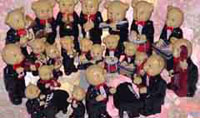Rembrandt, レンブラント
Above is just a small part of our gift-packed souvenir stamp-collection; inquire by email if the picture or subject of your interest is not here: we will be obliged to accomodate your wishes. ここに掲載の写真は一部のみです。ご希望のジャンル、絵柄などございましたらお問い合わせください。
レンブラント・ハルメンスゾーン・ファン・レイン(Rembrandt Harmenszoon van Rijn, 1606年7月15日-1669年10月4日)は17世紀を代表するオランダの画家。単にレンブラントと呼ばれることも多い。油彩だけでなく、エッチングや複合技法による銅版画やドローイングでも知られる。生涯を通じて数多くの自画像を描いたことでも知られる。自画像はその時々の彼の内面の変化まで伝えている。
レンブラントの自画像(1640年)
目次
[非表示]
1 生涯
2 レンブラント工房
3 作品の特徴
4 夜警
5 作品
6 外部リンク
生涯
1606年ライデン生まれ。1631年アムステルダムに移る。「トゥルプ教授の解剖講義」(1632年)で名声を得る。「夜警」(1642年)も集団肖像画の傑作として知られる。
しかし、私生活では最初の妻を早く亡くし(1642年)、愛人の女性から婚約不履行で訴えられるなど、トラブルが続いた。浪費癖もあったようで、多額の借金を抱えてやがて返済不能に陥る(1656年)。晩年は息子にも先立たれ、困窮のうちに亡くなり、共同墓地に葬られたという。また、レンブラント自身は色盲であったともいわれている。
レンブラントの自画像(1660年)
レンブラント工房
20世紀後半に研究が進み、かつてレンブラント作とされた作品の中に「工房作」のものが多く含まれていることがわかってきた。工房といっても、画家の下絵を弟子が仕上げていくといった分業体制ではなく、レンブラント工房の場合は、弟子がレンブラントの画風に従って制作しており、レンブラントが手を入れることはなかったようである。
作品の特徴
作品の一点(ないし複数の点)に暗闇に鋭く差し込むような光線が当てられ、その部分を強調すると同時に暗闇の部分を逆に強調する手法が特徴である。そのため光の画家と呼ばれることもある。生き生きとしたドラマチックな描写が見るものを画面に引き込むかのような魅力がある。
夜警
代表作「夜警」
レンブラントの著名な作品として『夜警』(1642年)が挙げられる(画面が黒ずんでいるため、夜の様子を描いたと考えられ、付けられた名前であるが、実際には左上から光が差し込んでおり、昼の時間である)。この作品は「フランク・バニング・コック隊長の市民隊」という題名であり、火縄銃手組合からの依頼で描かれた作品で、登場人物の各人が平等に描かれておらず、物議をかもしたようである。この作品の後、レンブラントへの注文が激減したという。しかし、火縄銃手組合本部に掲げられた絵画の出来栄えは圧倒的であり、レンブラントの評価を高めた。 この作品は現在、アムステルダム国立美術館にあるが、1715年までは火縄銃手組合のホールにあった。その後、ダム広場の市役所に移されたが、非常に大きな絵であるため、壁に入りきらないとして周りをカットされてしまった。特に左側が大きく切られたが、その部分のいずれも残っていない。また、1980年代にアムステルダム国立美術館において暴漢によってナイフで切られたことがある。12ヶ所余りを切られたが、現在では修復されている。
作品
自画像 (1629) アルテ・ピナコテーク(ミュンヘン)
テュルプ博士の解剖学講義(1632)マウリッツハイス美術館
ベルシャザルの祝宴 (1635) ナショナルギャラリー (ロンドン)
ガニュメデスの誘拐 (1635) ドレスデン国立美術館
アブラハムの犠牲 (1635) エルミタージュ美術館
目を潰されるサムソン(1636)シュテーデル美術館 (フランクフルト)
夜警(1642) アムステルダム国立美術館
修道士に扮する息子ティトゥス (1660) アムステルダム国立美術館
A selection of famous works
The anatomy lesson of Dr. Nicolaes Tulp.
1629 An Artist in His Studio (The Museum of Fine Arts, Boston, Massachusetts)
1630 The Raising of Lazarus (Los Angeles County Museum of Art, Los Angeles)
1630-1635 A Turk (The National Gallery of Art, Washington, D.C.)
1631 Portrait of Nicolaes Ruts (Frick Collection, New York)
1632 Anatomy Lesson of Dr. Nicolaes Tulp (Mauritshuis, The Hague)
1632 Portrait of a Noble (Oriental) Man (Metropolitan Museum of Art, New York)
1633 Christ in the Storm on the Lake of Galilee (formerly at the Isabella Stewart Gardner Museum, Boston; stolen in 1990 and still at large)
1635 Belshazzar's Feast (National Gallery, London)
1636 The Blinding of Samson (Stadelsches Kunstinstitut, Frankfurt am Main, Germany)
1636 Dana (State Hermitage Museum, St. Petersburg)
1642 The Militia Company of Captain Frans Banning Cocq better known as the Night Watch (Rijksmuseum, Amsterdam)
±1643 Christ Healing the Sick also known as The Hundred Guilders Print (Victoria and Albert Museum, London) etching, nicknamed for the huge sum (at that time) paid for it
1647 An Old Lady with a Book (The National Gallery of Art, Washington, D.C.)
1650 The Philosopher (The National Gallery of Art, Washington, D.C.)
1650 The Mill (The National Gallery of Art, Washington, D.C.)
1653 Sacrifice of Isaac (State Hermitage Museum, St. Petersburg)
1653 Aristotle with a Bust of Homer (Metropolitan Museum of Art, New York)
1654 Bathsheba at Her Bath (Louvre, Paris) (Hendrickje is thought to have modeled for this painting)
1655 Joseph Accused by Potiphar's Wife (National Gallery of Art, Washington D.C.)
1656 A Woman Holding a Pink (The National Gallery of Art, Washington, D.C.)
1656 Jacob Blessing the Sons of Joseph (Staatliche Kunstsammlungen Kassel, Galerie Alte Meister, GK 249)
1657 The Apostle Paul (The National Gallery of Art, Washington, D.C.)
1658 Selfportrait (Frick Collection, New York)
1658 Philemon and Baucis (The National Gallery of Art, Washington, D.C.)
1659 Jacob Wrestling with the Angel
1659 Selfportrait (Metropolitan Museum of Art, New York)
1660 Selfportrait (Metropolitan Museum of Art, New York)
1660 Portrait of a Gentleman with a Tall Hat and Gloves (The National Gallery of Art, Washington, D.C.)
1660 Portrait of a Lady with an Ostrich-Feather Fan (The National Gallery of Art, Washington, D.C.)
1661 Conspiracy of Julius Civilis (Nationalmuseum, Stockholm) (Julius Civilis led a Dutch revolt against the Romans) (most of the cut up painting is lost, only the central part still exists)
1662 Syndics of the Drapers' Guild (Dutch De Staalmeesters) (Rijksmuseum, Amsterdam)
1662 Portrait of a Man in a Tall Hat (The National Gallery of Art, Washington, D.C.)
1662-1663 A Young Man Seated at a Table (The National Gallery of Art, Washington, D.C.)
1664 Lucretia (The National Gallery of Art, Washington, D.C.)
1664 The Jewish Bride (Rijksmuseum, Amsterdam)
1666 Lucretia (The Minneapolis Institute of Arts, Minneapolis)
1669 Return of the Prodigal Son (State Hermitage Museum, St. Petersburg)
The above explanation comes from  出典: フリー百科事典"ウィキペディア"
出典: フリー百科事典"ウィキペディア"

